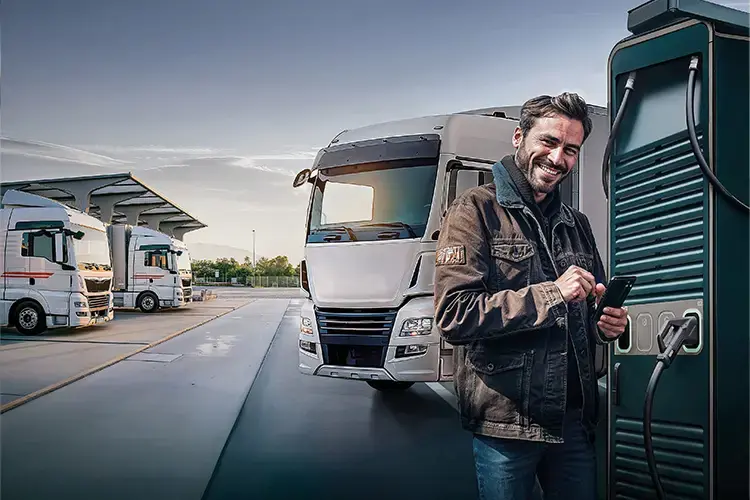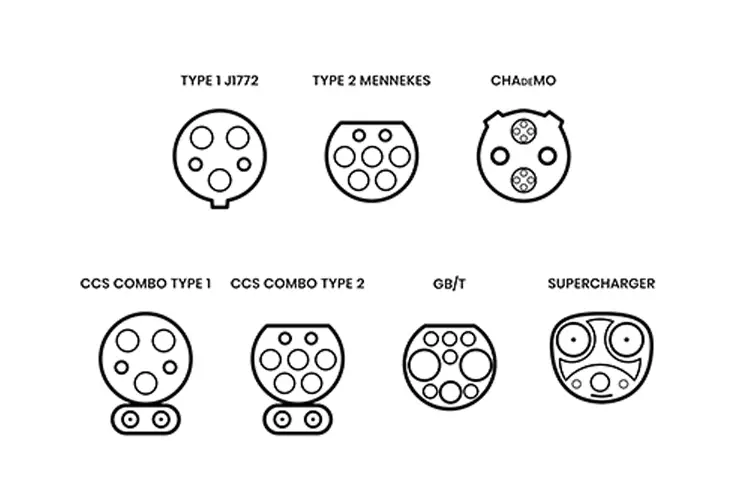Accelerating EV fast charging for europe’s electric truck revolution
Inhaltsverzeichnis
The most important facts in brief
- A rapid expansion of the charging network is required as the use of electric trucks increases.
- Milence is developing a specialized network of fast-charging stations for heavy vehicles in Europe, in partnership with UTA Edenred, to enhance accessibility and operational efficiency for electric trucks.
- Various types of fast-charging stations (up to 400 kW) are critical to reducing charging times and improving the readiness of electric truck fleets.
As the shift towards sustainability accelerates, more companies are increasingly investing in Battery Electric Trucks (BET). According to a PricewaterhouseCoopers International (PwC) report, in 2030 BET are forecasted to account for one third of all trucks in Europe, North America, and Greater China.1
This reflects a growing commitment to reducing carbon footprints and enhancing environmental sustainability in the transportation sector. In response, countries all over Europe are expanding their networks of electric vehicles (EV) fast charging stations to support this transformative shift in vehicle technology.
This article explores the pivotal aspects of EV fast charging, crucial for companies transitioning to electric fleets. It delves into the various charging speeds, the types of connectors available, and the critical factors that influence charging efficiency.

TOC - Inhaltsverzeichnis @ TRIALTA - Hier benötigen wir ein TOC Modul
- Thema 1
- Thema 2
- Thema 3
- Thema 4
EV charging types
Charging speeds for electric vehicles are measured in kilowatts (kW), which indicates the rate at which an EV’s battery is charged. Higher kW ratings mean faster charging speeds. For example, a 50 kW charger will recharge an EV much quicker than a 7 kW charger, provided the vehicle’s onboard charger can handle the higher power. This relationship between the power output of the charger and the charging speed is fundamental in selecting the appropriate charging infrastructure for specific needs and locations.
There are four main types of EV fast charging available, each offering different speeds to meet various charging demands:
Slow charging (level 1 charger)
Slow chargers are typically rated at speeds of up to 7.4 kW AC. These chargers are not only ideal for overnight charging, but also serve as an emergency alternative when faster options are not available. Type 2 and Type 1 EV charger connectors are the primary types used with slow chargers:
- Type 2 connectors: can handle up to 7.4 kW and have become the standard for European-made EVs.
- Type 1 connectors: also support up to 7.4 kW and are commonly found on older vehicle models.
Suitability for electric trucks: The typical charging time with slow chargers can be up to 12 hours for a full charge. Although they are mainly used at home, slow chargers are increasingly being used in workplaces and public places. However, as level 1 charging takes a long time, it is not suitable for electric trucks and only for emergencies.
Fast charging (level 2 charger)
Fast chargers offer a more rapid charging solution for electric vehicles, with charging speeds ranging from 7.4 to 22 kW AC. This type of charger is common both as a home charging point and across the public charging network.
The primary connectors used with fast chargers are Type 2 and Type 1.
- Type 2 connectors: Are capable of handling up to 22 kW AC and are widely adopted by modern EVs.
- Type 1 connectors: Support up to 7.4 kW AC and are typically found on older EV models.
Suitability for electric trucks: As the charging time for e-trucks is very long, similar to level 1 chargers, this charging method is also rather unsuitable.

Ultra rapid and rapid charging (level 3 charger)
Rapid and ultra-rapid EV chargers represent the pinnacle of efficiency in the realm of electric vehicle (EV) charging technology. The electricity in the charging station is converted in advance from alternating current (AC) to direct current (DC), which saves time when charging. This makes level 3 chargers ideal for electric trucks.
Rapid DC chargers typically provide power at 50 kW and use either CHAdeMO (CHArge de MOve) or CCS (Combined Charging System) standards. These chargers have been the standard for rapid EV charging for nearly a decade. On average, these can charge an EV to 80 percent within 20 minutes to an hour, depending on the battery's capacity and initial state of charge. Ultra-rapid chargers, offering even higher speeds starting from 100 kW and reaching up to 350 kW, significantly reduce charging time, managing to recharge an EV's battery to 80 percent in just about 20 minutes.
Both rapid and ultra-rapid chargers typically feature tethered cables, ensuring that the right type of connector is always available at the charging point. The primary connectors include:
- CCS (Combined Charging System): Supports up to 350 kW and is the most common type of rapid and ultra-rapid charging connection. It combines AC and DC ports in one connector, facilitating higher charging capacities.
- CHAdeMO: Depending on the generation, they can deliver up to 62.5 kW or even up to 400 kW (second generation).
- Type 2: This connector supports rapid charging up to 50 kW AC and is standard across a majority of EVs, although not all are capable of utilizing AC for rapid charging.
These charging systems are designed to maximise efficiency, providing a substantial charge in a minimal amount of time. As battery capacities increase, ultra-rapid chargers are evolving to offer even faster rates, ensuring that they can keep pace with the latest developments in EV fast charging technology. To minimise the stress on the battery, fleet managers can use adaptive charging algorithms that take battery capacity, temperature, etc. into account.
For effective fleet management: factors that affect charging speed
Several factors can affect the charging speed of electric vehicles:
- State of Charge (SoC): EV batteries charge faster when they have a lower SoC. As the battery fills up, the charging speed decreases, similar to how finding a seat in a nearly full cinema becomes more challenging.
- Battery temperature: Batteries need to be at an optimal temperature to charge efficiently. Both extremely cold and hot temperatures can slow down the charging process. EVs often have a thermal management system to regulate battery temperature for optimal charging.
- Concurrent loads: Using other features in your EV such as air conditioning, lights, or entertainment systems during charging can divert power away from the battery, slowing down the charging process.
- Battery condition: Over time, batteries may deteriorate and lose the capacity to hold a full charge, which can also affect the charging speed. This is usually included in the vehicle's warranty.
- Voltage and current limits: The maximum power an EV can accept is determined by both the vehicle and the charger's limits on voltage and current. The charging speed depends on matching these limits effectively.
EV fast charging: key developments in Europe for transport industry
Milence is significantly expanding its operations in France by establishing a new charging hub for heavy-duty vehicles in Heudebouville, near Rouen. This strategic location, between Paris and Le Havre, aims to support the growing demand for electric heavy-duty vehicles by providing a key logistical node in northern France.
It is scheduled to open in 2024 and will be equipped with high-performance chargers capable of delivering up to 400 kW each. Additionally, Milence is developing a second hub in Perpignan, which will serve as a critical point along the A9 highway, linking Spain with France and Northern Europe.

To effectively support electric trucks, a robust charging infrastructure is essential. This includes deploying high-performance charging stations along highways and providing depot charging for overnight energy replenishment. According to PwC, immediate steps include expanding to 120 stations by 2025 to ensure sufficient coverage and capacity. This expansion, necessitating investments up to 1 billion euros, is crucial to accommodate the anticipated increase in electric truck usage by 2025. Long-term, further investment will be required to scale up these facilities to meet growing demands.1
Milence has partnered with UTA Edenred to enable UTA customers to handle transactions at Milence stations. This enables UTA cardholders to use their cards at Milence stations to charge their electric truck. The collaboration is part of a broader initiative by UTA Edenred to facilitate the transition to electric trucks for its clients, aligning with Milence's goal of developing a leading European charging network specifically for heavy-duty traffic.
Sources:
[1]: https://www.strategyand.pwc.com/de/en/the-dawn-of-electrified-trucking.html
